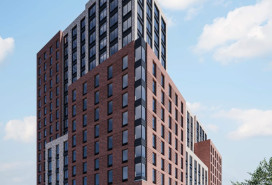How to sound off on the City of Yes housing proposal from Mayor Adams
- City of Yes for Housing Opportunity entered the public review period
- It will be presented to community boards and borough representatives
- Then the proposal goes to the City Planning Commission for a vote

An illustration of how removing parking mandates frees up space to be used for living from a guide to The City of Yes for Housing Opportunity.
Image courtesy of The Parking Reform Network/NYC Planning
If you have opinions about the City of Yes for Housing Opportunity, Mayor Eric Adams’ zoning reform proposal that aims to address New York City’s housing crisis by adding a “little more housing in every neighborhood,” now is your chance to share them.
The plan entered the public review period April 29th and is being presented to community boards, borough boards, and borough presidents for input and review.
Need to determine your community board? Check out this map. Once you have identified your community board, go to its website to find contact information. Each community board runs its own website. Dates for upcoming meetings can be found on this site.
After input from the community boards, City of Yes goes to the City Planning Commission for a vote. If passed, the City Council is expected to vote on the proposal by the end of 2024.
Big vision for a big problem
City of Yes for Housing Opportunity takes aim at NYC’s housing shortage, “which has been going on for so long that some take it as a fact of life that New York City is a place where rents always go up, housing is always hard to find, said Dan Garodnick, director of the NYC Department of City Planning, during a press briefing on Friday.
The vacancy rate—the percentage of unoccupied units—for NYC apartments today is 1.4 percent, That’s the lowest it’s been since 1968, Garodnick added.
Apartments in NYC are scarce, and expensive: Over 50 percent of renters are rent burdened, meaning they spent more than 30 percent of their income on rent, Garodnick said.
NYC is not keeping up with creating new housing, due in part to restrictive zoning rules that limit the amount and types of housing that can be built, he said.
More housing in every neighborhood
The solution, according to the Adams administration, is to have every neighborhood add more housing. Currently NYC’s housing production is mostly concentrated in 10 out of a total of 59 community districts.
By increasing zoning density, allowing taller buildings, converting offices into housing and other incremental changes, the city predicts the plan would create between 58,000 and 109,000 new housing units over 15 years.
Some of the key proposals for City of Yes for Housing Opportunity include:
Town center zoning: Add two to four stories of housing above commercial business, which is banned under current zoning.
Transit-oriented development: Allow three-to-five story apartment buildings in locations on wide streets or corners that are near subway or rail stations.
Accessory dwelling units: Permit backyard cottages, garage, and basement apartments, which would allow owners to earn rental income and provide space for multi-generational families.
Universal affordability preference: Allow buildings to add at least 20 percent more housing if the additional units are permanently affordable, broadening an existing rule aimed focused on affordable senior housing.
End parking mandates: The plan asserts that parking mandates make housing more expensive.
Convert non-residential buildings to housing: This would make it easier for office to be converted into housing.
Small and shared housing: Allow housing with shared kitchens and other common facilities, and buildings with more studios and one-bedroom apartments.
Campus infill: Make it easier to add new housing on sites that have existing buildings like churches.
Re-zoning reaction
Neighborhood rezonings are typically contentious, so it will be interesting to see the reaction is to what is essentially a city-wide rezoning.
In previous and ongoing NYC zoning battles, increasing density and allowing for taller building was distressing to longtime New Yorkers, who fear losing the character of their neighborhood or even displacement.
For Garodnick, it seems growing pains may be a risk worth taking.
“I believe that history will look back at this year as the moment that we turned the tide on housing in New York City,” he said.
You Might Also Like




























